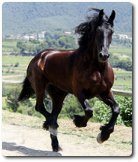Gerard Manley Hopkins, selected poems Contents
Imagery and symbolism in Inversnaid
A running horse
 The imagery of the poem is striking. The stream is first described as looking like the back of a horse with its mane streaming out as it gallops down a road. Here the stream is wide enough to look like a ‘highroad'. Its colour is also brown in its turbulence, like a horse, though it is more the particular shape of the water, its inscape, that fascinates Hopkins. So the foam is like a horse's hair, but just as if combed or ‘fluted' (here having an architectural meaning of fine lines cut into stone to give pattern). The sound is represented by ‘roaring'.
The imagery of the poem is striking. The stream is first described as looking like the back of a horse with its mane streaming out as it gallops down a road. Here the stream is wide enough to look like a ‘highroad'. Its colour is also brown in its turbulence, like a horse, though it is more the particular shape of the water, its inscape, that fascinates Hopkins. So the foam is like a horse's hair, but just as if combed or ‘fluted' (here having an architectural meaning of fine lines cut into stone to give pattern). The sound is represented by ‘roaring'.
Delicacy and strength
In stanza two, the visualization is of the spray over the pool. The contrast is between the delicacy of the spray and the powerful solid turbulence of the whirlpool like movements of the body of water. So ‘windpuff bonnet' suggests delicacy, whereas ‘rounds and rounds' conveys strength. By contrast, as the burn is followed upstream, it almost becomes a person treading through the heather. The personification is increased with the picture of the ‘beadbonny ash' sitting over the burn.
The last stanza is striking in its absence of imagery. There is a rhetorical question and a wish, but the words mean exactly what they say. After the complexity and precision of the earlier stanzas, the contrast is striking.
- Which image or images strike you most forcefully?
Recently Viewed
Related material
Scan and go

Scan on your mobile for direct link.